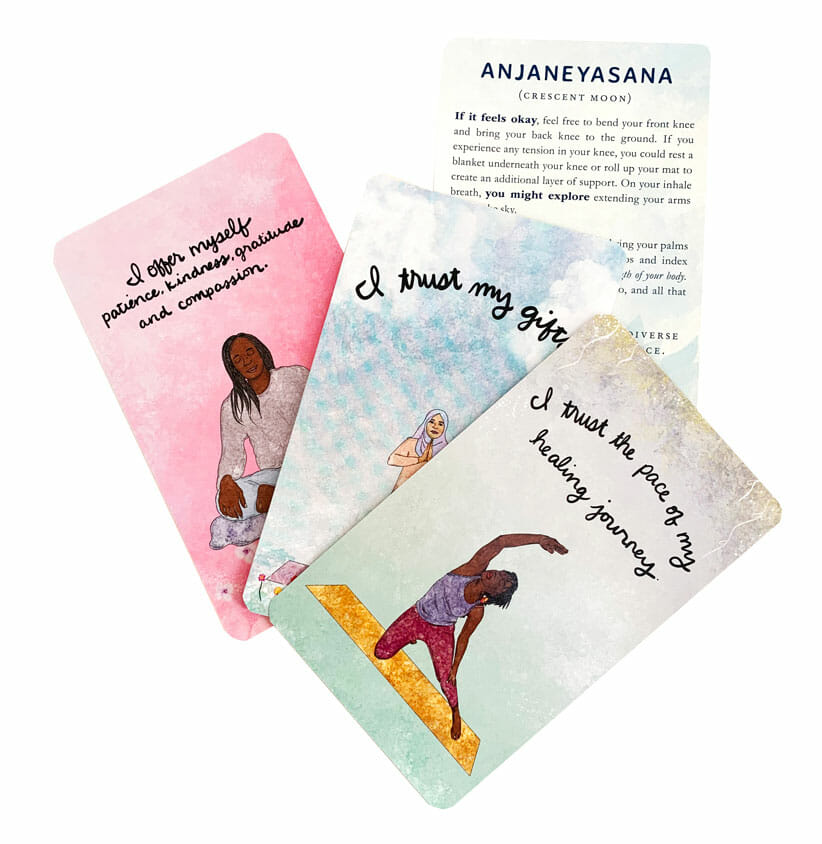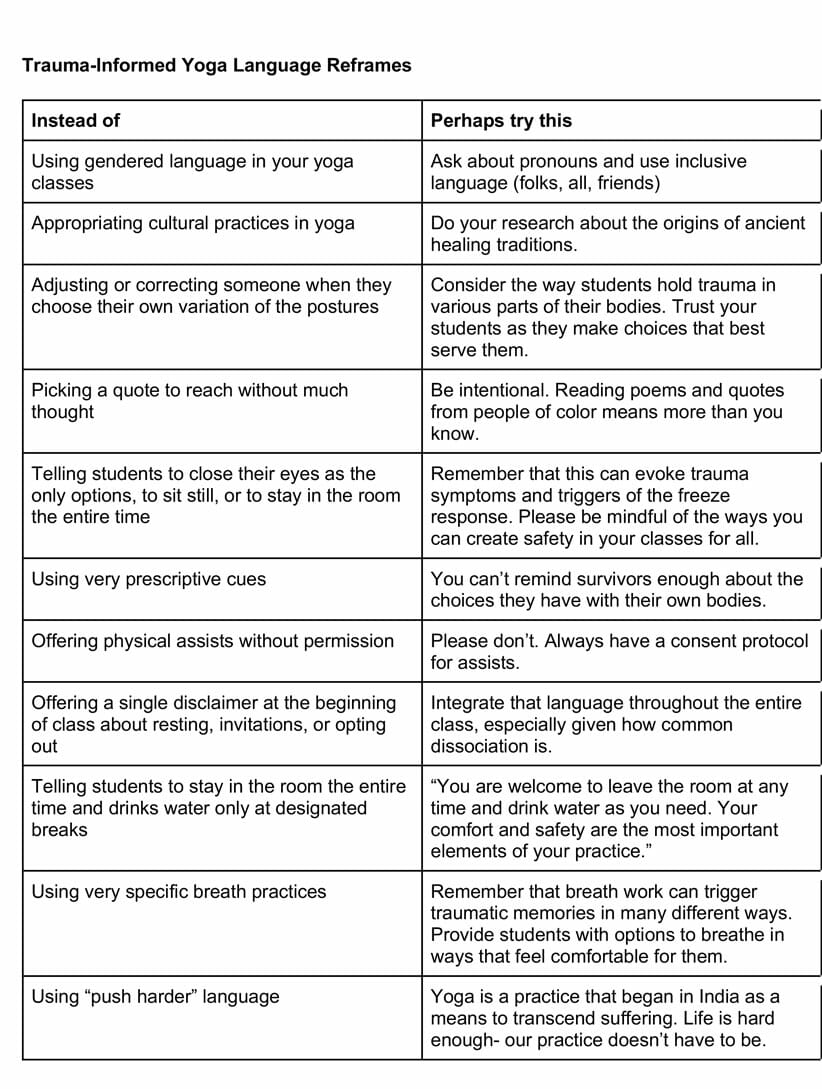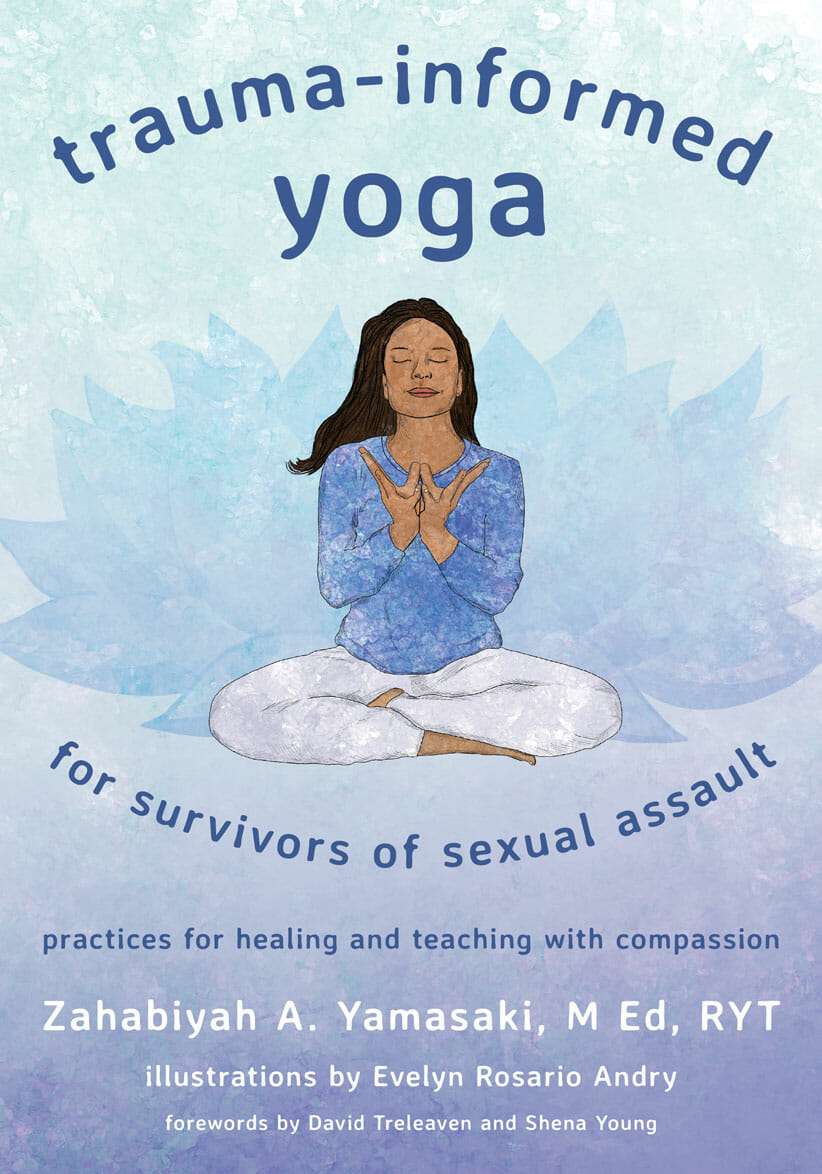
Zabie Yamasaki photo by Leanne Sargeant
Intentionality and Empathy in Teaching: What it Means to Be A Trauma-Informed Yoga Instructor
“Never have I felt so safe without having to speak a single word about my assault.” I’ll never forget the day when a survivor shared these words with me after participating in an eight-week trauma-informed yoga series for sexual-assault survivors. Every part of her was beaming. I think that is the power of survivors gathering in circles to share community, connect in their truth and the power of their stories, move and breathe at their own pace, and celebrate the choices they have with their own bodies. As she accessed safety in the space, her capacity for connection also increased. It was a defining moment for me in the scope of my work as a trauma-informed yoga instructor. And it was a powerful reminder of the need for this body-based modality to be accessible and integral to the services that are offered at universities, trauma agencies, rape crisis centers, and clinical settings across the country.
I have witnessed something so moving by offering this practice from a trauma-informed lens: Survivors—of all gender identities, racial and ethnic backgrounds, sexual orientations, and abilities—can finally feel and believe with every part of their bodies that their trauma does not define them. The practice is a reminder of their innate capacity to heal and that they are never alone in their experience.
I still remember the very first trauma-informed yoga series that I taught, nearly 10 years ago. I remember the butterflies. I remember the passion. I remember the pathways for healing that suddenly became possible. I began teaching trauma-informed yoga classes in the community for many reasons. To support survivors in what is oftentimes a lifelong process of healing. To create spaces in which to love ourselves throughout the journey and be reminded that our pain is not invisible. To affirm that we are not broken and that we can return to our bodies on our own terms. To support empowerment and empathy and space in which to be seen. To foster compassion when we tap into the deep knowing that there may be no sense of finality to this thing called healing. To hold on fiercely to our worthiness amid the many storms we will navigate in this life. To let ourselves be present with moments of relief and of joy. To consciously practice self-love with the many paradoxes of healing and hurt, courage and fear, joy and grief. To know that there are many entry points to healing.
While I specialize in working with survivors of sexual trauma, I firmly believe in the profound healing and power of integrating trauma-informed frameworks into all teaching settings.
I take into account all of the ways trauma impacts a student’s mind, body, and spirit and offer intentionality and sensitivity into the way that I teach. I honor each student’s pace, remind them that their choices are celebrated, offer many variations of each posture, integrate invitational language, trauma-sensitive breath practices, and co-create with them. We are not having uniform experiences and I remind students often that their lived experience is their greatest teacher. As yoga teachers, I believe we have an obligation to be mindful of the way trauma shows up for our students, the same way we are around physical injuries.
The Philosophy of Being Trauma-Informed
The commitment to being a trauma-informed practitioner and a trauma-informed yoga instructor is is lifelong. Being trauma-informed is a philosophy and a systemic framework of the way we truly see people and honor their humanity. It is leaning in and doing the work of being an ally, educating ourselves, being aware of our biases, and engaging in inclusive and culturally affirming practices.
It is at all costs avoiding re-traumatization. It helps us to compassionately and empathetically hold a safe container. It allows every interaction to be a powerful reminder: people are the experts of their own experience.
Trauma-informed yoga supports students in activating their parasympathetic nervous system and creates more space for safety, rest, growth, and abundant joy. When given these tools, students can also access greater depths of inner capacity and resilience in navigating not only chronic stress, trauma, and crisis but also the everyday challenges that life presents.
One of the first places I started teaching yoga from a trauma-informed lens was at a CrossFit gym. At first I think the students were not quite sure who the hell I was and what I was doing. But as I invited more softness into the cues and reminded them that their choices were celebrated and that they were enough just as they are…you could quite visibly see the ways they were able to be more compassionate with themselves. I know so often we carry those experiences off of the mat. It was beautiful to be witness to.
I envision that one day every 200 hour yoga teacher training will be required to include curricula on trauma. The numbers speak volumes. There are survivors of trauma practicing with us every single day. They deserve to be supported with compassion and care. They deserve to know that their pain is not invisible.

Affirmations from the Trauma-Informed Yoga Affirmation Card Deck
Grounding Survivors in their own Worthiness
I feel that so much of my work as a trauma-informed yoga instructor entails helping to ground survivors in their own worthiness. I think a lot about various fitness spaces and so often students are affirmed in class when they are only in the most advanced version of the posture. This adds to the daily messages that we should be pushing harder or doing more. We already receive these messages constantly in the context of our hurried world. Our language is a powerful tool that we can offer when teaching yoga to affirm that rest is one of the most productive choices we can make for ourselves.
Some of the frameworks of teaching from a trauma-informed lens include:
- Empowering and invitational language
- Anti-oppression lens
- Accessibility
- Holding a safe container and supportive space
- Sensitivity to triggers
- Safety of the physical environment
- Trauma-sensitive breathwork
- Consent framework for assists
- Self and community care for teacher and students
If you are looking for a starting point, I invite you to view the chart below for some language re-frames which are further explored in my book, Trauma-Informed Yoga for Survivors of Sexual Assault: Practices for Healing and Teaching with Compassion.

Our research at the University of California has shown the following benefits of trauma-informed yoga:
- The recognition of choice’s in one’s life
- Feelings of safety and strength
- Ability to be more expressive in therapy
- Positive coping skills
- Self-care strategies
- Understanding of how to ask for help
- Improved trust in self and others
- Development of a strong sense of community
- The establishment of boundaries and understanding how to be assertive
- Decreased feelings of depression, stress, and anxiety
- Decreased symptoms of PTSD
- Empowerment to seek additional resources
- Increased confidence and courage
- Increased feelings of self-compassion
- Increased awareness of needs, mindfulness skills and resiliency
- Strengthened self-esteem
- Increased feelings of being seen, valued, and affirmed
- Strengthened emotional, physical, mental, spiritual, and interpersonal skills

Zabie Yamasaki photo by Leanne Sargeant
The Capacity of the Human Spirit for Healing
For centuries survivors have also known this to be true in their bodies. Something that has carried me in the process of birthing and writing my book is just how important it is for survivors to be invited to trust in the beauty and power of their own experience.
As a survivor of sexual assault, I struggled for years with the physiological impact of trauma on my body. I knew I wasn’t alone and I wanted to create a program that spoke to the language of the body, was soulful, intersectional, and culturally affirming at its core.
I wanted to be intentional about supporting survivors in what can oftentimes be a life-long process of healing. I also felt passionate about providing a compassionate framework for healing professionals who want to integrate trauma-informed yoga into the scope of their work.
The capacity of the human spirit to heal amidst the unfathomable is something that continues to take my breath away. There is so much power in truly seeing people and empowering them to make choices that best serve them. The yoga as healing program has been an intersection of both of my worlds as I have been propelled on this journey to learning how powerful yoga can be as a tool for healing trauma.
Following this path has also allowed me to trust the power of my voice. As a survivor and a woman of color, it has taken me years to believe in myself. I never imagined in a million years that my trauma-informed yoga curriculum would be implemented at over 30 college campuses and trauma agencies. It is an honor to support your journey of healing and teaching.

Order Trauma-Informed Yoga for Survivors of Sexual Assault
The book and affirmation deck published by Norton: Trauma-Informed Yoga for Survivors of Sexual Assault: Practices for Healing and Teaching with Compassion will be released in 2022 and is currently available for pre-order.
Zabie Yamasaki, M.Ed., RYT (she/her) is the Founder of Transcending Sexual Trauma through Yoga which is an organization that offers trauma-informed yoga to survivors, consultation for universities and trauma agencies, and training for healing professionals. Zabie has trained thousands of yoga instructors and mental health professionals and her trauma-informed yoga program and curriculum is now being implemented at over 25 college campuses and trauma agencies including the University of California (UC) system, Stanford, Yale, USC, University of Notre Dame, and Johns Hopkins University.
Zabie received her undergraduate in Psychology and Social Behavior and Education at UC Irvine and completed her graduate degree in Higher Education Administration and Student Affairs at The George Washington University. Her work has been highlighted on CNN, NBC, KTLA 5, and The Huffington Post.
Zabie is widely recognized for her intentionality, soulful activism, and passionate dedication to her field. She is a trauma-informed yoga instructor, resilience and well-being educator, and a sought after consultant and keynote speaker. She has worked with thousands of survivors to support them in their healing journey, ground them in their own worthiness and remind them they are inherently whole. Zabie centers survivors in her work, and provides them with tools to help uncover trauma imprints, support the healing process, create balance of the nervous system, and lessen the grip that past experiences of trauma may have on the heart.
She is a survivor, mother, partner, daughter, sister, friend, and activist. She has received countless awards in victim services and leadership, including the Visionary in Victim Services award from one of the largest rape crisis centers in California. Her book and affirmation deck published by Norton: Trauma-Informed Yoga for Survivors of Sexual Assault: Practices for Healing and Teaching with Compassion will be released in January 2022. It is currently available for pre-order.
